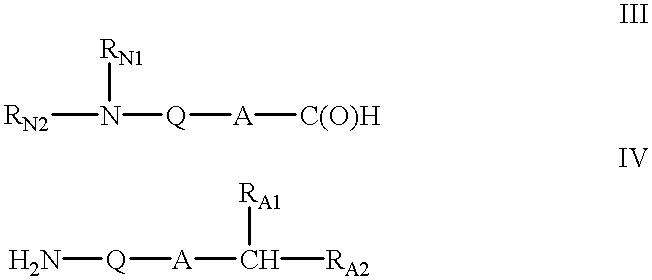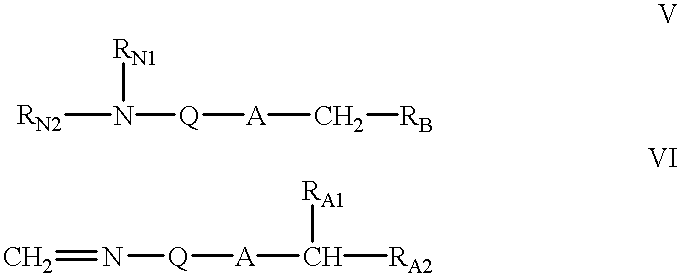Oligonucleotide mimics having nitrogen-containing linkages
a technology of oligonucleotide mimics and oligonucleotide, applied in the field of oligonucleotide mimics, can solve the problems of insufficient activity of many previously available antisense oligonucleotides for practical therapeutic, research or diagnostic purposes, and the inability to use unmodified oligonucleotides as useful therapeutic agents, etc., to facilitate sequence specific binding of oligonucleotide mimics
- Summary
- Abstract
- Description
- Claims
- Application Information
AI Technical Summary
Benefits of technology
Problems solved by technology
Method used
Image
Examples
example 2
Reductive Coupling
Solution Phase Synthesis of Oligomeric Molecule Linked Via Amino Linkages (FIG. 2)
The `first unit` for this synthesis is the same as used in Example 1, above.
A. Synthesis of Bifunctional Units, 4-Pentenyl-1-amine, 15, and 3-(N,N-diphenyl imidazolidine)-butyl-1-amine, 13.
Treatment of 4-penten-1-ol 1 (r=1) with methlysulfonyl chloride in pyridine at 0.degree. C. affords the sulfonate, which on treatment with lithium azide in DMF gives azido derivative 14. Reduction of 14 with tributyltin hydride in dimethyl acetamide furnishes title compound 15.
Yet another bifunctional unit 13 is prepared in five steps, starting from 1. The hydroxyl group initially is protected with t-butyldiphenyl silyl group and the product, on oxidative cleavage using OsO.sub.4 / NaIO.sub.4, gives aldehyde 3 (R.sub.Z =TBDPS). The latter compound is further transformed to the imidazolidine derivative 4, which on desilylation followed by conversion of the hydroxyl group to an amino group via an azide...
example 3
Nucleophilic Coupling
Oligomeric Molecules Linked Via Amino Linkages (FIG. 3)
FIG. 3 describes a general method for assembly of amino linked linear molecules. Further methods are described by Niitsu, et. al., Chem. Pharm. Bull. 1986, 31, 1032.
A. Synthesis of First Unit, 23
The title compound is prepared from commercial 1, 3-propanediol, which on monosilylation with t-butyldiphenylsilylchloride gives protected 20 (R.sub.Z =TBDPS, r=1). The free hydroxyl group of 20 is then converted into a tosyl leaving group as described by J. March in Advanced Organic Chemistry, Reactions, Mechanisms, and Structure, page 352, John Wiley & Sons, New York, 1992 to furnish 23 (R.sub.L =O-tosyl). Other suitable leaving groups include brosylates, nosylates, mesylates or halides.
B. Synthesis of Bifunctional Unit, 22
Treatment of 3-bromo-1-propanol with lithium azide in DMF furnishes 3-azido-1-propanol, which on silylation provides 21 (L.sub.S =TBDPS, r=1). The azido group of 21 is reduced to provide the bifu...
example 4
Reductive Coupling
Solution Phase Synthesis of an Oligmeric Molecule Linked Via Hydroxylamine Linkages (FIG. 4)
A. Synthesis of a `First Unit`, Amino-O-benzylalcohol, 27
Title compound 27 is prepared in two steps starting from commercial benzyl alcohol 25 (L.sub.S =phenyl). In the first step, Mitsunobu reaction of 25 with N-hydroxyphthalimide / triphenylphosphine / diethylazodicarboxylate gives an o-phthalimido derivative 26. Treatment of 26 with methylhydrazine gives 27.
B. Synthesis of a `Bifunctional Unit`, 3
Title compound 3 is prepared in a manner described in Example 1, above.
C. Coupling of a `First Unit` and a `Bifunctional Unit`
A mixture of 27, 3, and acetic acid is stirred in CH.sub.2 Cl.sub.2 for 1 h at room temperature. The solvent is evaporated to furnish the crude oxime 28, which on reduction with NaBH.sub.3 CN / AcOH (as described in Example 11 of Ser. No. 08 / 039,979, filed Mar. 30, 1993, now abandoned,) furnishes 29. The amino group of 29 is further reductively alkylated with N1...
PUM
| Property | Measurement | Unit |
|---|---|---|
| temperature | aaaaa | aaaaa |
| pH | aaaaa | aaaaa |
| pH | aaaaa | aaaaa |
Abstract
Description
Claims
Application Information
 Login to View More
Login to View More - R&D
- Intellectual Property
- Life Sciences
- Materials
- Tech Scout
- Unparalleled Data Quality
- Higher Quality Content
- 60% Fewer Hallucinations
Browse by: Latest US Patents, China's latest patents, Technical Efficacy Thesaurus, Application Domain, Technology Topic, Popular Technical Reports.
© 2025 PatSnap. All rights reserved.Legal|Privacy policy|Modern Slavery Act Transparency Statement|Sitemap|About US| Contact US: help@patsnap.com



